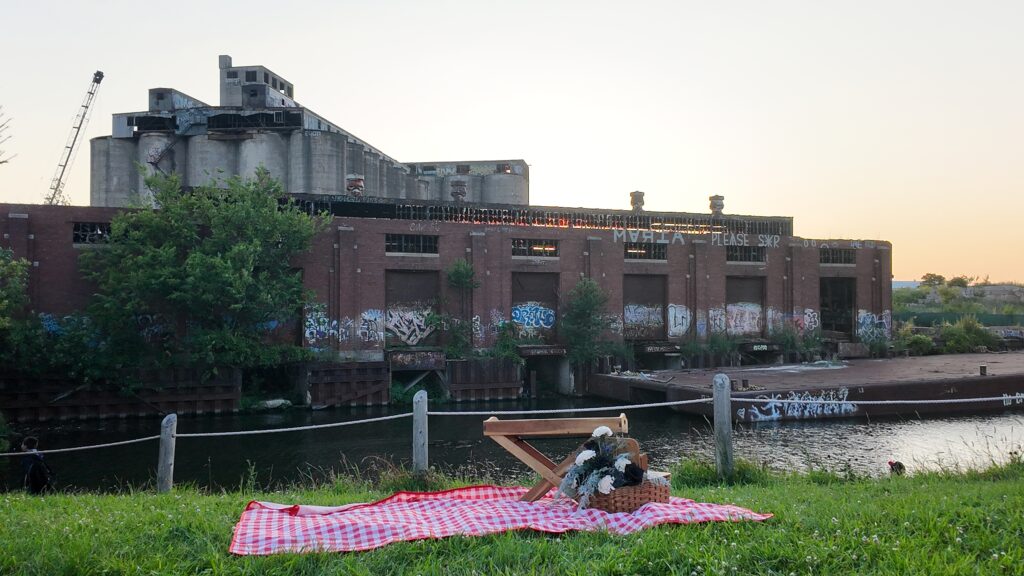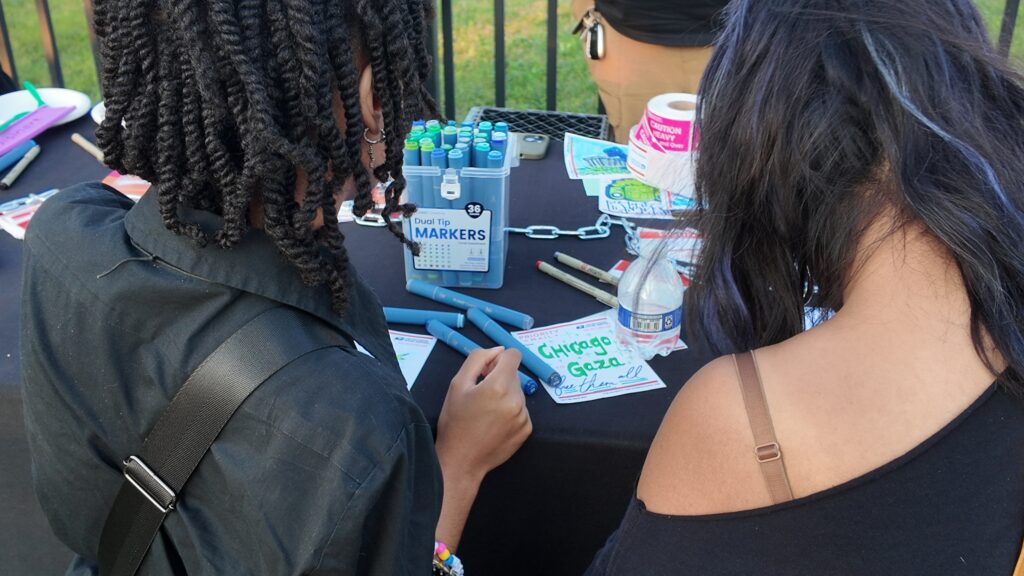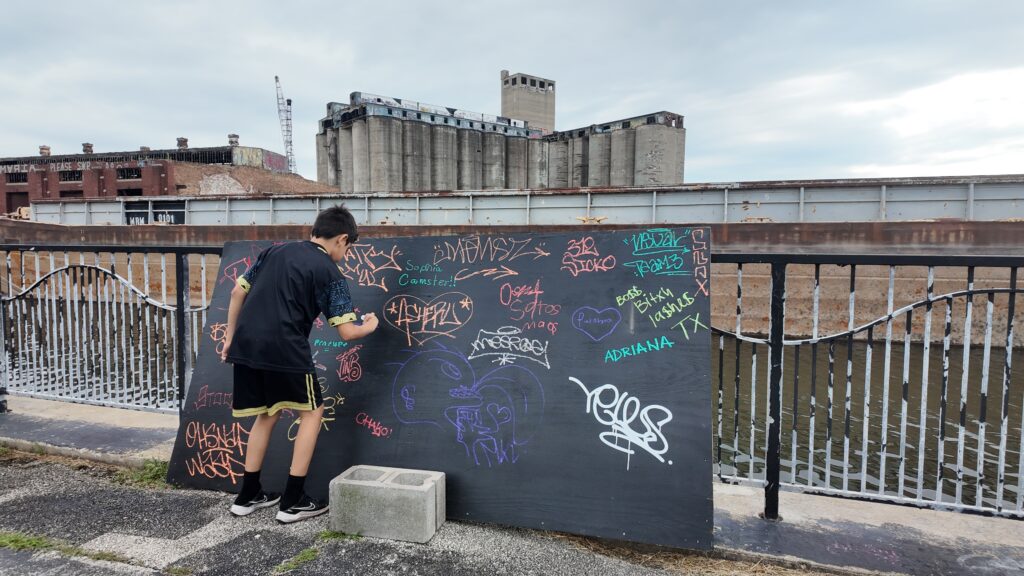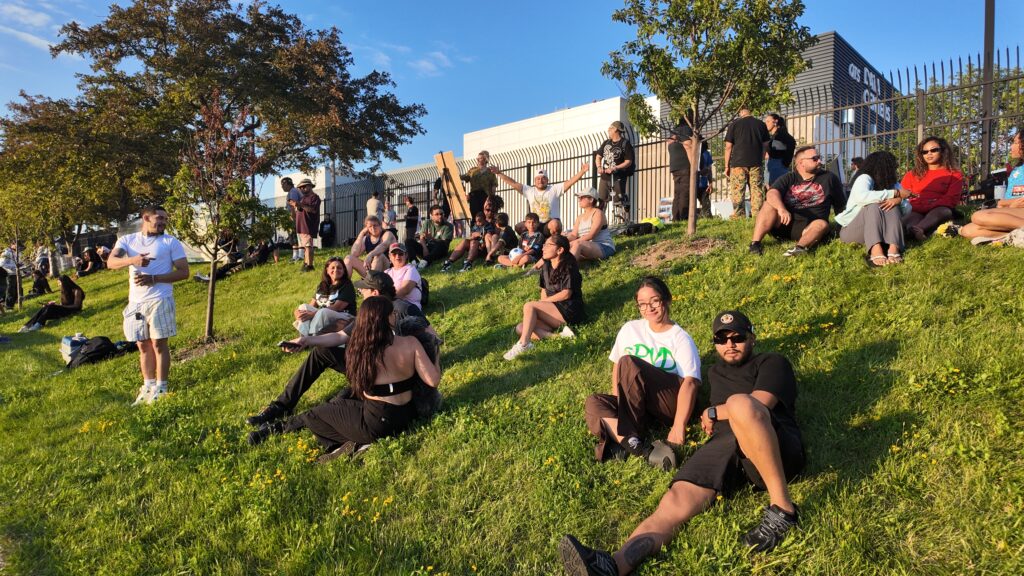It was on a picturesque Sunday afternoon when I found myself walking along the Canalport River Walk—a stretch of path nestled at the blurred edge where Pilsen, McKinley Park, and Bridgeport meet. It was my first time there. A striking duality revealed itself: A serene strip of greenery found along the trail, and across the Chicago River, the industrial ruins of construction sites and long-abandoned warehouses decorated in graffiti. As I approached closer to my destination, the intoxicating aroma of spray paint began to fill my nostrils followed by the nostalgic tunes of classic ’90s and 2000s hip-hop.
The X on the map I was following was none other than the historic Damen Silos. This weekend would be its last days standing, and in order to send off the South Side landmark properly, I pulled up to a community picnic happening right across from it on the river walk. As the DJ continued playing boom bap’s greatest hits, graffiti artists (also known as writers) tagged plastic wrap wrapped between trees and wooden boards placed along the guardrail lining the river. A cannabis consumption station for dabs offered free hits, and skaters practiced tricks further along the trail. I found myself smoking a joint on the grassy knoll, quietly observing everything around me in this makeshift island of misfit toys.
All I could think was, “Yeah… this is exactly my kind of vibe.”
This gathering was curated by local creatives, namely graffiti artist Asheru and the sister duo behind SRVD Floral Lounge, AnaKaren and Odalys “The Flower Dealer” Ramirez.
“We’re not your typical flower shop,” AnaKaren said. “We’ve started hosting and putting together events and other things through the flower shop, even outside of the [shop], and this is one of them… we actually resonate with the Damen Silos. It’s something that we see through our commute often, it’s something on our side of the city.”
According to Odalys, the goal of this gathering was not just meant to give nearby neighbors a final chance to say goodbye, but to also invite anyone who has never been to the Silos or the Canalport River Walk and experience it for the very first time. To make the event more immersive, different stations were set up for people to engage in, such as the aforementioned dab station, a slap making station for people to write tags on USPS stickers, and a designated skateboarding area set up by Prosper Skateshop. The SRVD Floral Lounge station provided flowers for people to spray paint. As true products of their environments, the sisters enjoy bringing their community together and incorporating elements that were commonly seen in their upbringing, hence their natural appreciation for graffiti culture.
“I express myself in these [flower] arrangements by incorporating different elements such as spray paint and glitter,” she says. “I went [into the Silos] as a young adult and creative. I was curious, and wanted to see the art inside of there back in 2016. I wanted to scope around even though I knew it was dangerous. I did this as a young adult, and wouldn’t do it now as a grown adult.”
The Damen Silos today serves as one of Chicago’s last remnants of a once-strong agrarian economy. Previously owned by the state government, it was abandoned as the city’s industrialization expanded, and has been empty for close to fifty years. As time passed, the Silos became an alternative third space for writers looking to push the envelope of hard-to-reach, yet highly visible places they can leave their tags and for urban explorers searching for their next thrill. It also became a filming location for numerous local music videos—most notably “GWM” featuring Vic Mensa and Towkio of the once-up-and-coming collective SaveMoney, and most recently, “Blue Collar Anthem” by The Blue Collar Rockstars–
and even the occasional summer blockbuster.
“I’ll put it like this, I met so many delinquents here just growing up in the neighborhood,” said community member and artist Evan Siebert. “It’s always been a spot graffiti writers can come to, you can look at the layers and layers of graffiti, old and new. It’s been a staple for delinquents and movie sets. You know Transformers 3 was filmed here.”
While Siebert says he’s never tagged the Silos himself, as a teenager, he climbed up to the top of one of them. According to him, the site was a proving ground for young outcasts.
“It’s like one of those spots to go to as a teenager to feel like you’re really cool. You come here, you trespass, you climb, it’s like a rebellious test of courage, going to the Silos,” Siebert said. “It’s not particularly hard to get into, it’s not hard to find either. I feel like it was definitely a gateway. I like exploring places I’m not supposed to be at, and there’s like a whole subculture of kids who do that.”
Even some of the country’s most renowned muralists and writers honed their skills within the confines of the Damen Silos. One such writer is Amuse126, whose work is internationally recognized and can be found anywhere from alleyways to art galleries.
“They’re part of the graffiti community or far beyond, everybody kind of had this [as] a location that gets called out, ‘Oh, have you seen those buildings off Damen?’” he recalls. “Seeing that off the expressway in such main streets like Ashland and Damen and the Orange line… as a Northside kid, this was always like a destination for me. First time I painted them was in 2004.”
Amuse126 also explains how urban legends about the Silos traveled within the graffiti community. Rumors of graffiti crews setting up booby traps or sabotaging access points in the building to prevent anyone from painting over their tags only added to the allure of the Silos. Despite these internal conflicts among crews, he feels that the Silos’ true value came from the fact that they helped normalize graffiti for the average person.
“It just added to the landscape, and helped normalize [graffiti] being a part of the landscape,” he said. “I think the best significance from this building was the fact that it just let people see it, and the graffiti just naturally added to it throughout the years, making it feel more rebellious and exclusive. It will be missed, but it will be cool to move on from it. It’s been here long enough.”
What is next for the Damen Silos?
That still remains up in the air for the land’s current proprietor, a controversial asphalt company known as MAT Limited that purchased the property in 2023 for $6.5 million from the state in an auction. In 2022, members of the McKinley Park environmental group Neighbors for Environmental Justice protested the sale of the Silos to the company. They advocated the Silos be converted into some type of concert venue or festival grounds similar to the Salt Shed. There are also concerns from neighbors about the air pollution that can occur as a result of the demolition. In 2020, a coal plant was demolished via explosives and blanketed the Little Village neighborhood in a dust cloud. This was something on the top of the mind for the event organizers of the picnic.
“While planning this, we were actually very concerned about that, as many community members were,” AnaKaren said. “We were keeping up with the schedule and the plan of how they were going to take them down. It looks like they learned from their previous experiences that explosives weren’t something that they’re trying to do this time around. With the machinery that they’ve been using, it looks like they’re tearing them down [mechanically] and also incorporating water to keep the dust from spreading.”
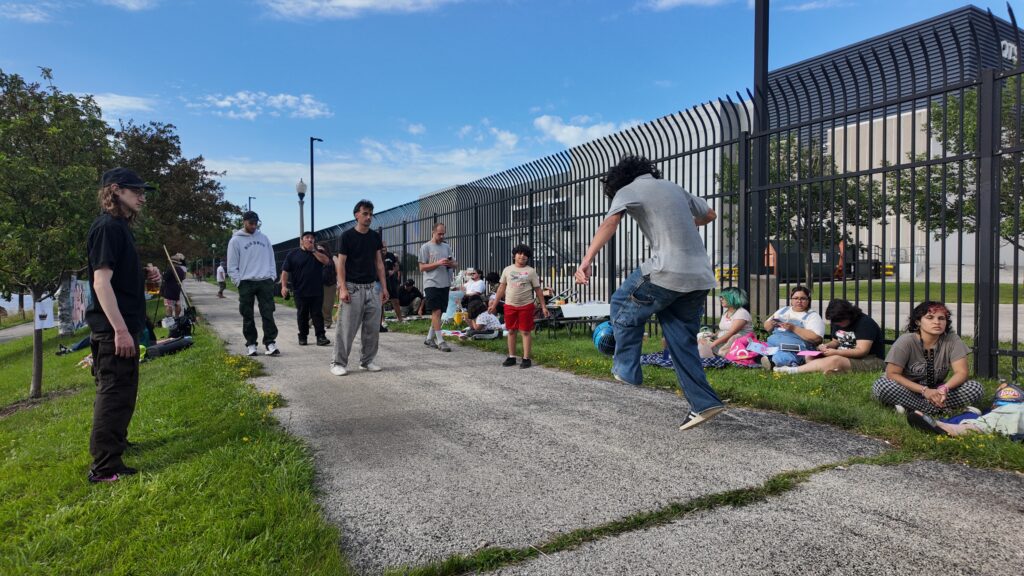

As the sun set on the Silos to close the day and the final chapter of Chicago’s agrarian past, people gathered together to admire the view for one last time. From children to seniors, South Siders and North Siders, delinquents and even a nearby cop, all were able to enjoy a peaceful Sunday evening picnic celebrating an art form and place that has long been ostracized by mainstream society. For AnaKaren, the goal of the event was accomplished.
“There’s a lot of history with the Damen Silos, from the grain company to it being abandoned, and [becoming] a home of a lot of graffiti artists. I’ve also heard that people raved in there.”
Alejandro Hernández is a freelance writer born and raised in Chicago. Growing up in the city gave him the sense of perspective that can be found in his work. With combined experience doing broadcast and written journalism, Alejandro has been actively documenting the stories of everyday Chicagoans for over seven years.


